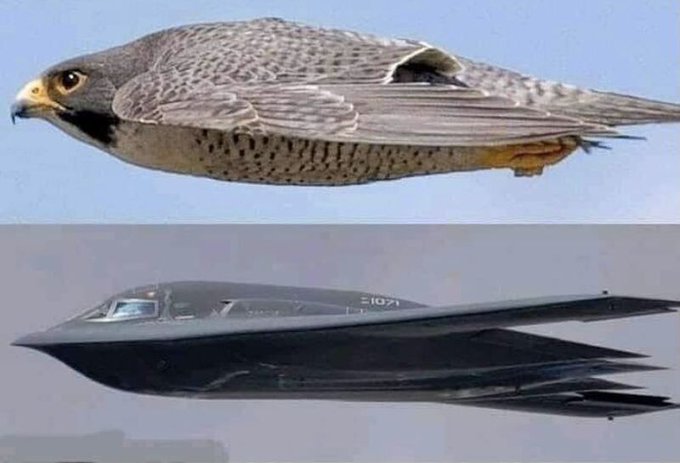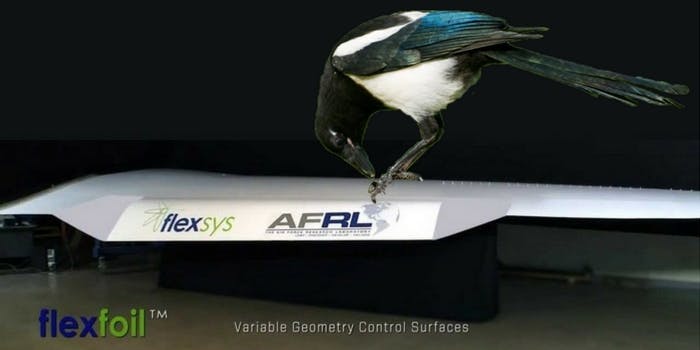How animals inspire aircraft design ?
Nature plays just as much a part in this, as science. Early aviation pioneers studied birds and bats – which were already highly-evolved at taking flight – to work out how to emulate them. And still today, our industry continues to be inspired by the animal world.
Aircraft with beating wings
The goal of all aviation engineers is to make flight more efficient – so their aircraft can fly further, faster and use less fuel in the process.
A few years ago, NASA partnered with Flexsys and Air Force Research Laboratory to develop a revolutionary wing, with a ‘flapping’ motion, inspired by the wing movements of birds.
The highly-flexible design could go through a full range of positions and angles during a flight, in the same way as a bird’s wing. NASA says the innovative wing is designed to increase fuel efficiency and noise on take-off and landing.
Flexys has continued to invest in other shape-adaptive and shape-morphing technology, for aerospace and other industries.
The Sky Whale by Oscar Viñals
The AWWA ‘Sky Whale’ is an enormous passenger aircraft concept, by Spanish designer and aviation enthusiast Oscar Viñals – with its shape inspired by the largest mammal on earth.
Three storeys high, with 755 seats and a wingspan of 88m (compared to 80m for an Airbus A380). Oscar Viñals claims the design is the ‘greenest aircraft imaginable’, incorporating environmentally-friendly technical solutions, to reduce drag, weight and fuel consumption.
The design also features advanced safety features, self-repairing wings and solar panels in the roof to charge onboard electronics.
Despite its size, the AWWA Sky Whale would have rotatable engines that can tilt like a Harrier jump jet, enabling a near vertical take-off on shorter runways.
Some doubt the design could translate into reality. Aircraft MIT professor Mark Drela believes the Sky Whale would be too big to be able to fly.
But Oscar Viñals was not deterred and went on to develop another nature-inspired aircraft concept: The Progress Eagle. This design features ultra-lightweight materials and uses solar energy and turbines to generate electricity during flight.
Flying spies: The Bat & Swift
Smaller flying animals have inspired engineers to create small, unmanned monitoring devices, with cameras that scan the ground and the sky – just as birds do when hunting for prey.
RoboSwift is inspired by the Swift. The small bird can fold its wings back to control its speed and its stability in the air.
The device has three cameras, one facing the ground. The cameras can be used to observe swifts in their natural environment and the images can be connected to virtual reality helmets.
COM-BAT, which has a design inspired by a bat, flies on solar energy and has a camera on the front. More discreet than a conventional drone or UAV, its mission is to gather information for the US Army.
Animal-inspired ground transport
Animals have not only inspired aircraft design, but ground transport too.
Japan is well known for the efficiency of its trains. The Shinkansen is the high speed train system, and its 700 series design was directly inspired by the Kingfisher.
Japanese trains can reach 322 km/h. This high speed is a problem at tunnel exits where the compressed air pressure causes a big ‘boom’. To address this problem, engineers looked to the technique of Kingfisher, which can dive at high speed into water, yet emerge with no splash.
By equipping their trains with a beak-shaped nose, similar to the Kingfisher’s, the researchers were able to alter the air pressure at the exit of the tunnels, and reduce noise.
Also on the ground, the McLaren P1 is an example of a car whose design is inspired by a large sea fish: The sailfish. The turbo swordfish can accelerate very rapidly over short distances, with its scales and skin designed to optimise speed and reduce drag. The designers closely observed the characteristics of the fish to increase the aerodynamics of the P1.
A stuffed sailfish now takes pride of place on the wall of the McLaren research offices.
Hits: 50













